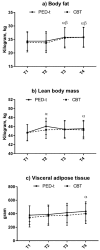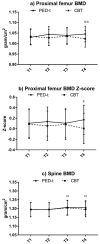Managing Risk of Non-Communicable Diseases in Women with Bulimia Nervosa or Binge Eating Disorders: A Randomized Trial with 12 Months Follow-Up
- PMID: 30513892
- PMCID: PMC6315508
- DOI: 10.3390/nu10121887
Managing Risk of Non-Communicable Diseases in Women with Bulimia Nervosa or Binge Eating Disorders: A Randomized Trial with 12 Months Follow-Up
Abstract
Persons with bulimia nervosa (BN) or binge eating disorder (BED) have an elevated risk of non-communicable diseases (NCDs). However, lowering this risk is rarely addressed in standard cognitive-behavioral treatment (CBT). We aimed to compare CBT with an intervention combining physical exercise and dietary therapy (PED-t), and hypothesized that the PED-t would do better than CBT in lowering the risk of NCD both initially and longitudinally. In this study, 164 women with bulimia nervosa or binge eating disorder were randomly assigned to 16-weeks of outpatient group therapy with either PED-t or CBT. Body composition (BC) was measured by dual-energy X-ray absorptiometry. Measures of physical fitness (VO₂peak and one repetition maximum (1RM) in squats, bench press, and seated row) were also recorded. All measurements were completed baseline, post-treatment, and at 6- and 12-month follow-ups, respectively. Our results showed that PED-t improved more than CBT on mean (99% CI) absolute Vo2peak; 57,2 (84.4, 198.8) mL (g = 0.22, p < 0.001) post-treatment. There were small to medium long-term differences in 1RM after PED-t compared to CBT. BC deteriorated in both groups during follow-up. Neither the PED-t nor the CBT lowered the risk for NCDs. Clearly, other approaches need to be considered to promote physical fitness and lower the risk of NCDs among individuals with BN and BED.
Keywords: binge eating disorder; bulimia; eating disorders; exercise; nutrition; obesity; physical activity; physical fitness; visceral adipose tissue.
Conflict of interest statement
The authors declare no conflict of interest. The funders had no role in the design of the study; in the collection, analyses, or interpretation of data; in the writing of the manuscript, or in the decision to publish the results.
Figures



Similar articles
-
Metabolic profile in women with bulimia nervosa or binge-eating disorder before and after treatment: secondary analysis from the randomized PED-t trial.Eat Weight Disord. 2023 Apr 27;28(1):41. doi: 10.1007/s40519-023-01567-y. Eat Weight Disord. 2023. PMID: 37103592 Free PMC article. Clinical Trial.
-
The PED-t trial protocol: The effect of physical exercise -and dietary therapy compared with cognitive behavior therapy in treatment of bulimia nervosa and binge eating disorder.BMC Psychiatry. 2017 May 12;17(1):180. doi: 10.1186/s12888-017-1312-4. BMC Psychiatry. 2017. PMID: 28494809 Free PMC article. Clinical Trial.
-
Comparing cognitive behavioural therapy for eating disorders integrated with behavioural weight loss therapy to cognitive behavioural therapy-enhanced alone in overweight or obese people with bulimia nervosa or binge eating disorder: study protocol for a randomised controlled trial.Trials. 2015 Dec 18;16:578. doi: 10.1186/s13063-015-1079-1. Trials. 2015. PMID: 26683478 Free PMC article. Clinical Trial.
-
The Efficacy of Psychological Therapies in Reducing Weight and Binge Eating in People with Bulimia Nervosa and Binge Eating Disorder Who Are Overweight or Obese-A Critical Synthesis and Meta-Analyses.Nutrients. 2017 Mar 17;9(3):299. doi: 10.3390/nu9030299. Nutrients. 2017. PMID: 28304341 Free PMC article. Review.
-
Cognitive Behavior Therapy for the Eating Disorders.Psychiatr Clin North Am. 2019 Jun;42(2):169-179. doi: 10.1016/j.psc.2019.01.001. Epub 2019 Apr 2. Psychiatr Clin North Am. 2019. PMID: 31046920 Review.
Cited by
-
Metabolic profile in women with bulimia nervosa or binge-eating disorder before and after treatment: secondary analysis from the randomized PED-t trial.Eat Weight Disord. 2023 Apr 27;28(1):41. doi: 10.1007/s40519-023-01567-y. Eat Weight Disord. 2023. PMID: 37103592 Free PMC article. Clinical Trial.
-
Psychiatric and medical comorbidities of eating disorders: findings from a rapid review of the literature.J Eat Disord. 2022 Sep 5;10(1):132. doi: 10.1186/s40337-022-00654-2. J Eat Disord. 2022. PMID: 36064606 Free PMC article. Review.
-
Study protocol: prevalence of low energy availability and its relation to health and performance among female football players.BMJ Open Sport Exerc Med. 2022 Jan 10;8(1):e001219. doi: 10.1136/bmjsem-2021-001219. eCollection 2022. BMJ Open Sport Exerc Med. 2022. PMID: 35087684 Free PMC article.
-
Eating Disorders and Obesity: The Challenge for Our Times.Nutrients. 2019 May 11;11(5):1055. doi: 10.3390/nu11051055. Nutrients. 2019. PMID: 31083490 Free PMC article.
-
Is physical exercise and dietary therapy a feasible alternative to cognitive behavior therapy in treatment of eating disorders? A randomized controlled trial of two group therapies.Int J Eat Disord. 2020 Apr;53(4):574-585. doi: 10.1002/eat.23228. Epub 2020 Jan 16. Int J Eat Disord. 2020. PMID: 31944339 Free PMC article. Clinical Trial.
References
-
- Kaminsky L.A., Arena R., Myers J. Reference Standards for Cardiorespiratory Fitness Measured with Cardiopulmonary Exercise Testing: Data From the Fitness Registry and the Importance of Exercise National Database. Mayo. Clin. Proc. 2015;90:1515–1523. doi: 10.1016/j.mayocp.2015.07.026. - DOI - PMC - PubMed
-
- Mathisen T.F., Rosenvinge J.H., Friborg O., Pettersen G., Stensrud T., Hansen B.H., Underhaug K.E., Teinung E., Vrabel K., Svendsen M., et al. Body composition and physical fitness in women with bulimia nervosa or binge-eating disorder. Int. J. Eat. Disord. 2018;51:331–342. doi: 10.1002/eat.22841. - DOI - PMC - PubMed
-
- Myers J., McAuley P., Lavie C.J., Despres J.P., Arena R., Kokkinos P. Physical activity and cardiorespiratory fitness as major markers of cardiovascular risk: Their independent and interwoven importance to health status. Prog. Cardiovasc. Dis. 2015;57:306–314. doi: 10.1016/j.pcad.2014.09.011. - DOI - PubMed
Publication types
MeSH terms
Grants and funding
LinkOut - more resources
Full Text Sources

